inflation pressure TOYOTA RAV4 2010 XA30 / 3.G Owners Manual
[x] Cancel search | Manufacturer: TOYOTA, Model Year: 2010, Model line: RAV4, Model: TOYOTA RAV4 2010 XA30 / 3.GPages: 513, PDF Size: 9.05 MB
Page 4 of 513

TABLE OF CONTENTSIndex
4
Security and system setup ................................ 289
Using the phone book ........ 292
3-4. Using the interior lights Interior lights list ................. 300
• Personal/interior light main switch ...................... 301
• Personal/interior lights...... 301
• Interior light ...................... 302
• Luggage compartment light .................................. 302
3-5. Using the storage features List of storage features....... 304
• Glove box ......................... 305
• Console box ..................... 306
• Overhead console ............ 307
• Cup holders ...................... 308
• Bottle holders ................... 309
• Auxiliary box ..................... 311
3-6. Other interior features Sun visors .......................... 312
Vanity mirrors ..................... 313
Clock .................................. 314
Power outlets ..................... 315
Seat heaters ....................... 318
Armrest............................... 320
Coat hooks ......................... 321
Floor mat ............................ 322
Luggage compartment features ............................ 323 4-1. Maintenance and care
Cleaning and protecting the vehicle exterior ........... 330
Cleaning and protecting the vehicle interior ............ 333
4-2. Maintenance Maintenance requirements .................... 336
General maintenance ......... 338
Emission inspection and maintenance (I/M)
programs .......................... 341
4-3. Do-it-yourself maintenance Do-it-yourself service precautions ....................... 342
Hood ................................... 346
Positioning a floor jack........ 348
Engine compartment .......... 350
Tires.................................... 365
Tire inflation pressure ......... 372
Wheels................................ 376
Air conditioning filter ........... 378
Key battery ......................... 380
Checking and replacing fuses ................................. 384
Light bulbs .......................... 396
4Maintenance and care
Page 7 of 513
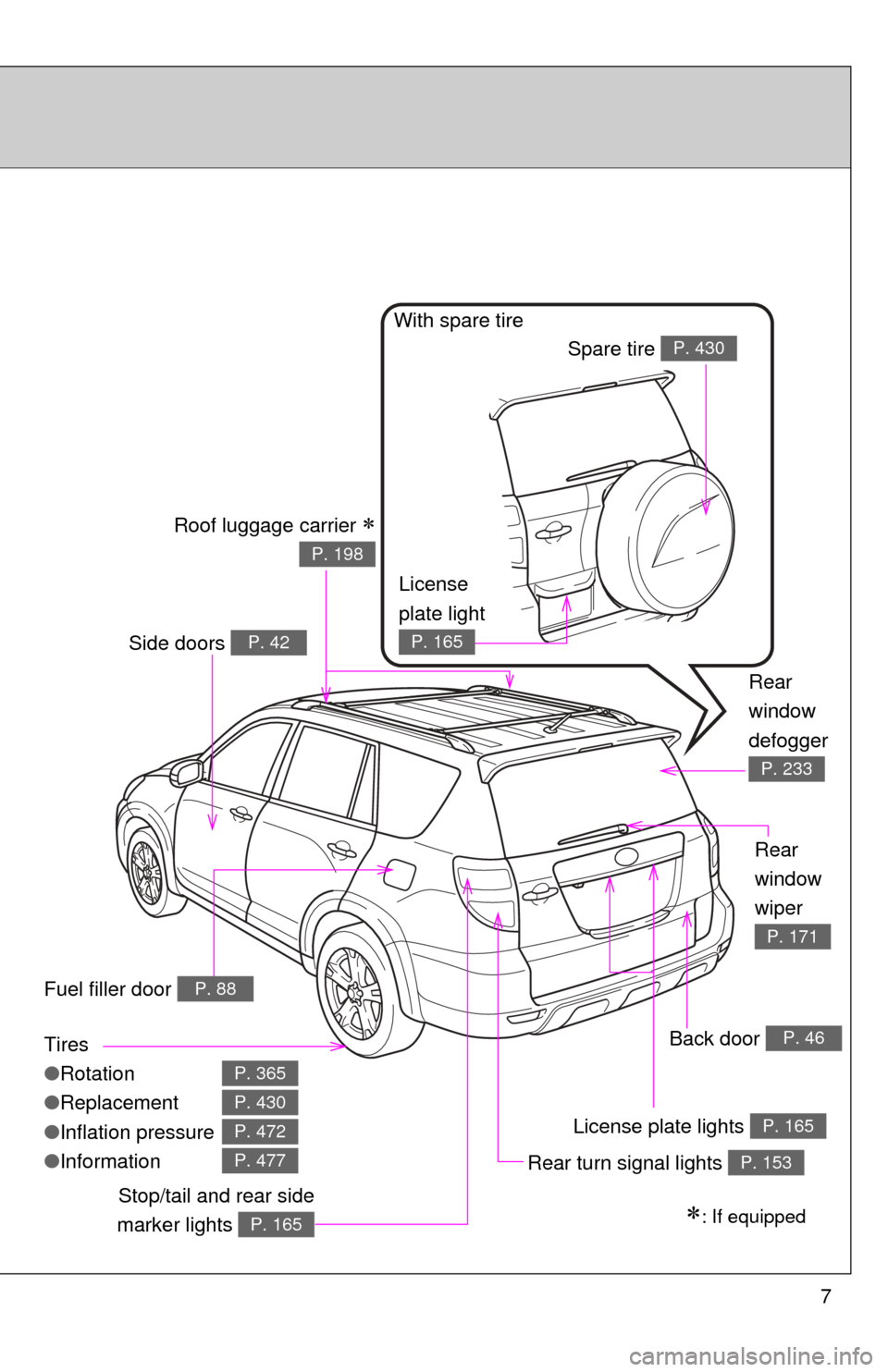
7
Tires
â—ŹRotation
â—Ź Replacement
â—Ź Inflation pressure
â—Ź Information
P. 365
P. 430
P. 472
P. 477
Back door P. 46
Rear turn signal lights P. 153
: If equippedStop/tail and rear side
marker lights
P. 165
Rear
window
wiper
P. 171
License plate lights P. 165
Side doors P. 42
Rear
window
defogger
ď€
P. 233
License
plate light
P. 165
With spare tire Spare tire
P. 430
Fuel filler door P. 88
Roof luggage carrier 
P. 198
Page 330 of 513
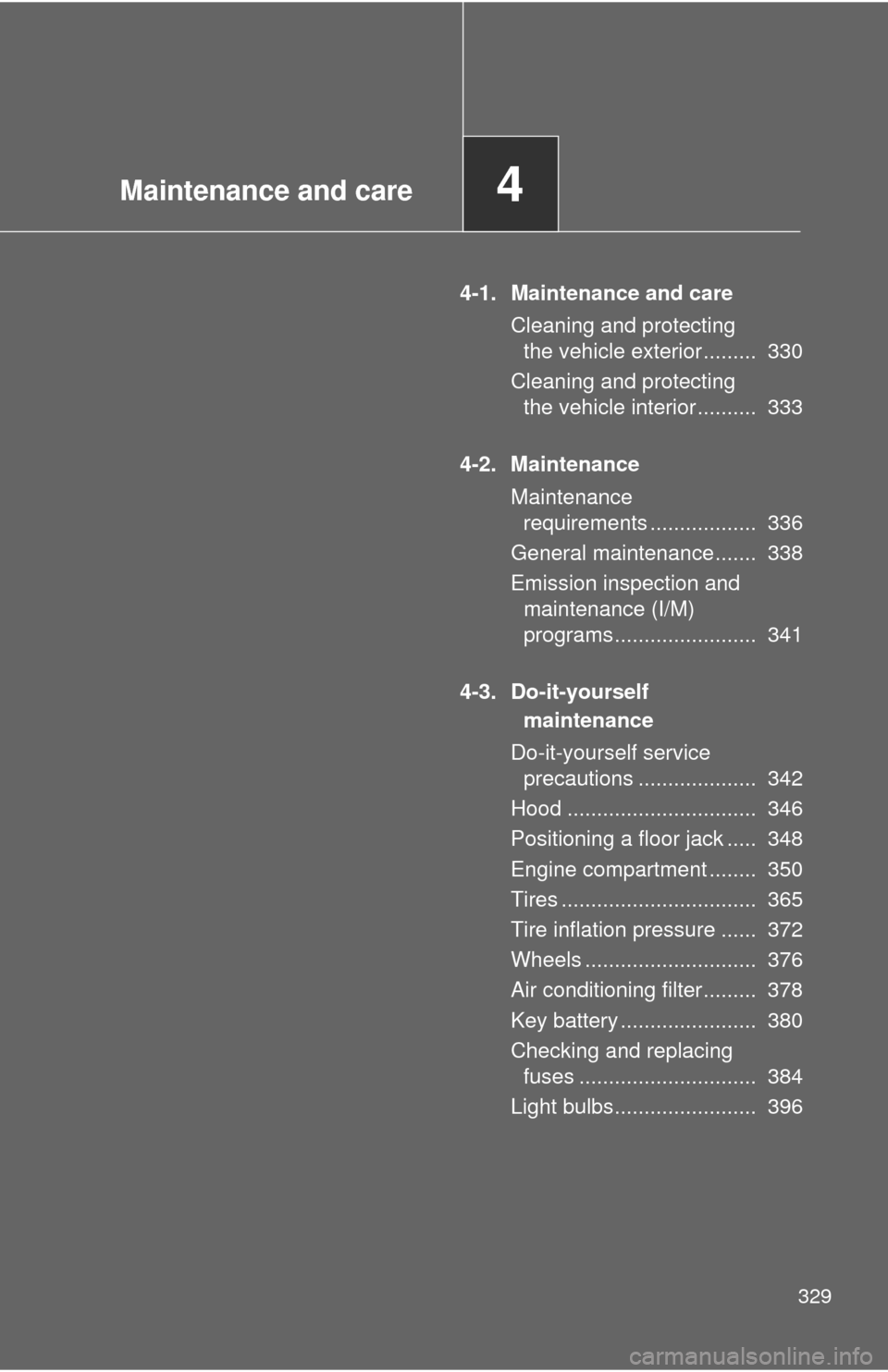
Maintenance and care4
329
4-1. Maintenance and careCleaning and protecting the vehicle exterior ......... 330
Cleaning and protecting the vehicle interior .......... 333
4-2. Maintenance Maintenance requirements .................. 336
General maintenance....... 338
Emission inspection and maintenance (I/M)
programs........................ 341
4-3. Do-it-yourself maintenance
Do-it-yourself service precautions .................... 342
Hood ................................ 346
Positioning a floor jack ..... 348
Engine compartment ........ 350
Tires ................................. 365
Tire inflation pressure ...... 372
Wheels ............................. 376
Air conditioning filter......... 378
Key battery ....................... 380
Checking and replacing fuses .............................. 384
Light bulbs........................ 396
Page 341 of 513
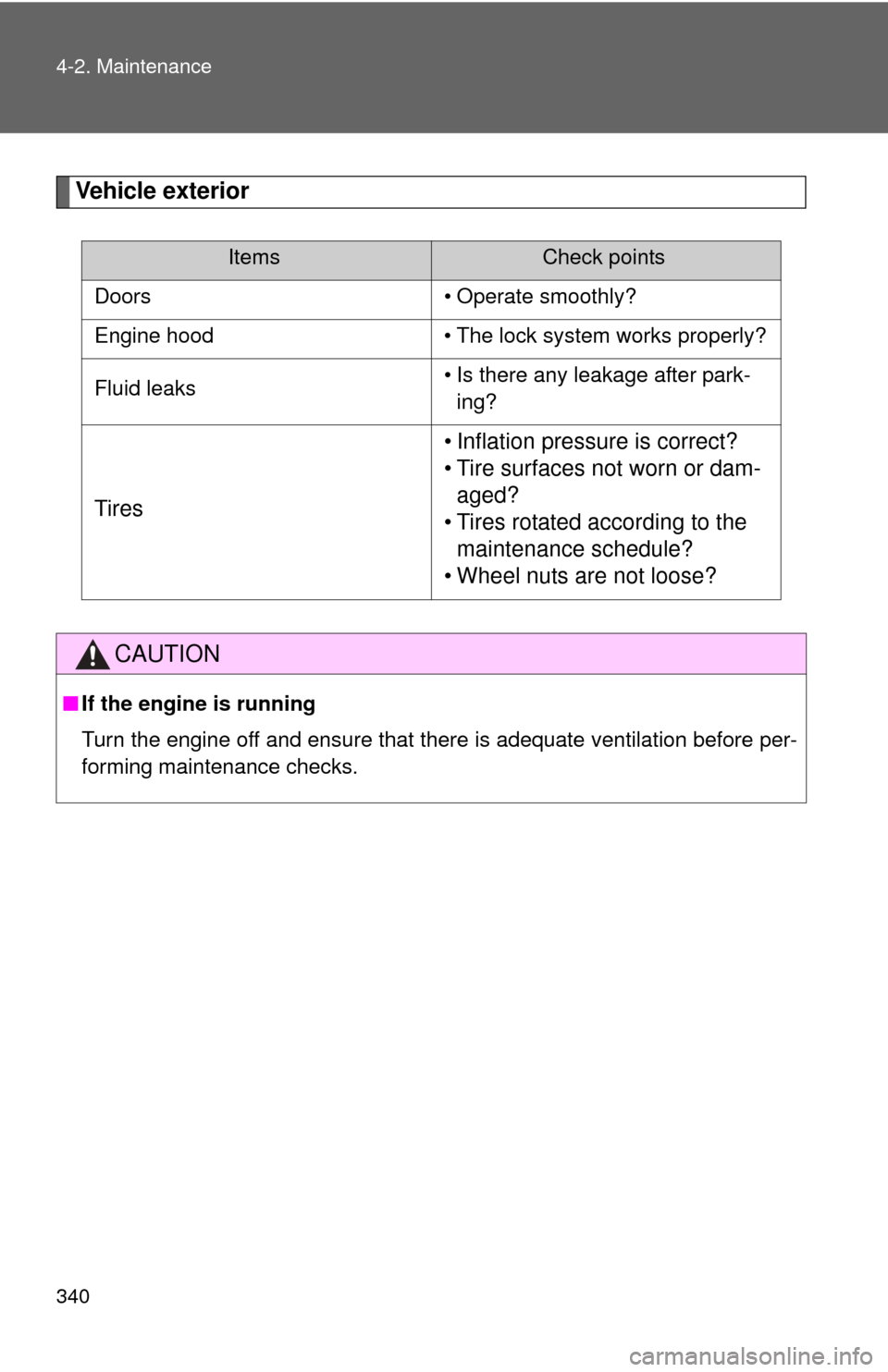
340 4-2. Maintenance
Vehicle exterior
ItemsCheck points
Doors • Operate smoothly?
Engine hood • The lock system works properly?
Fluid leaks • Is there any leakage after park-
ing?
Tires • Inflation pressure is correct?
• Tire surfaces not worn or dam-
aged?
• Tires rotated according to the maintenance schedule?
• Wheel nuts are not loose?
CAUTION
â– If the engine is running
Turn the engine off and ensure that there is adequate ventilation before per-
forming maintenance checks.
Page 344 of 513

343
4-3. Do-it-yourself maintenance
4
Maintenance and care
ItemsParts and tools
Fuses ( P. 384)• Fuse with same amperage rating
as original
Radiator and condenser (ď‚®P. 358) ď‚ľ
Tire inflation pressure (
P. 372) • Tire pressure gauge
• Compressed air source
Washer fluid
(P. 364) • Water washer fluid containing
antifreeze (for winter use)
• Funnel
Light bulb (P. 396) • Bulb with same number and watt-
age rating as original
• Flathead screwdriver
Page 366 of 513
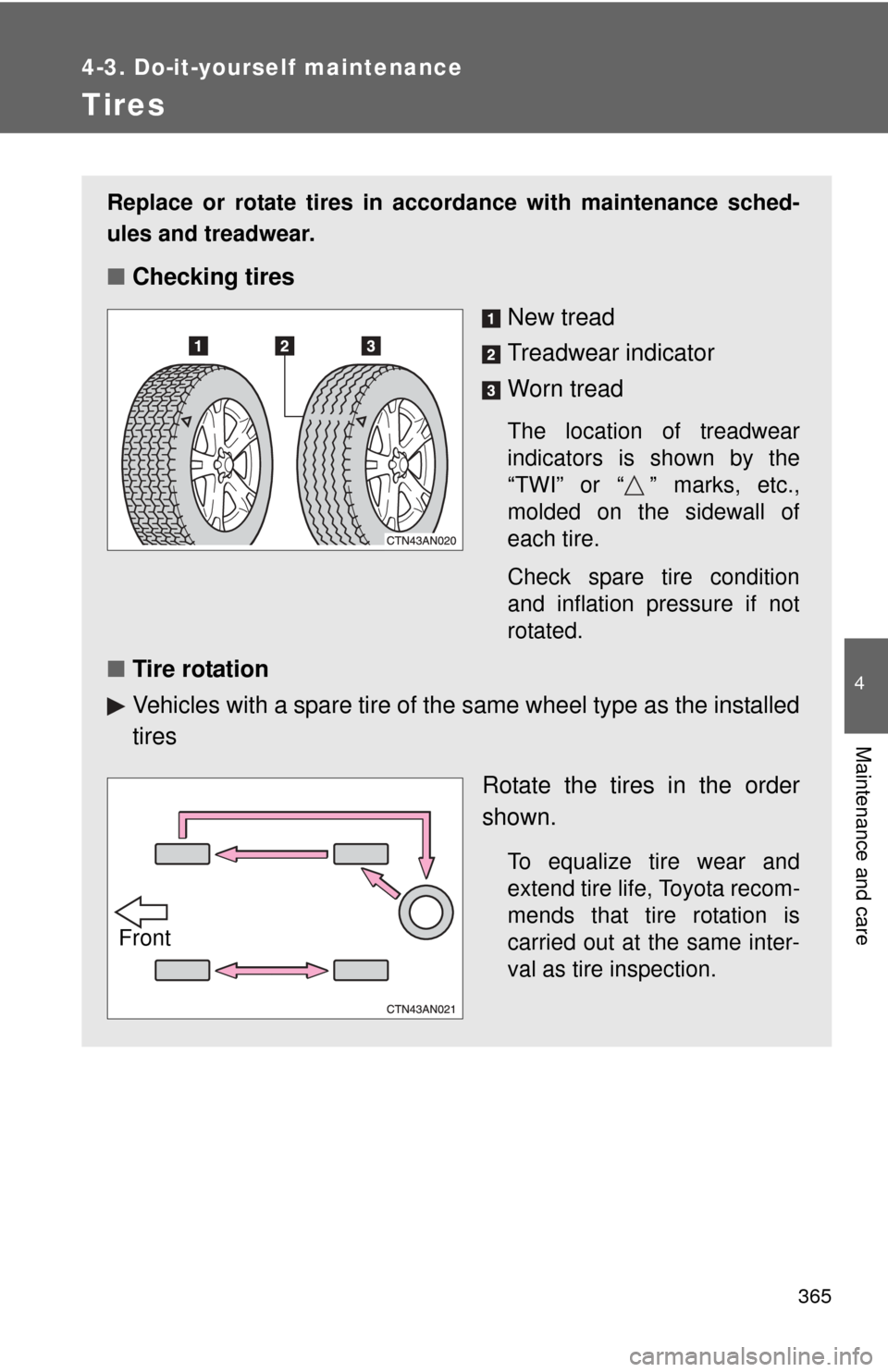
365
4-3. Do-it-yourself maintenance
4
Maintenance and care
Tires
Replace or rotate tires in accordance with maintenance sched-
ules and treadwear.
â– Checking tires
New tread
Treadwear indicator
Worn tread
The location of treadwear
indicators is shown by the
“TWI” or “ ” marks, etc.,
molded on the sidewall of
each tire.
Check spare tire condition
and inflation pressure if not
rotated.
â– Tire rotation
Vehicles with a spare tire of the same wheel type as the installed
tires
Rotate the tires in the order
shown.
To equalize tire wear and
extend tire life, Toyota recom-
mends that tire rotation is
carried out at the same inter-
val as tire inspection.
Front
Page 367 of 513
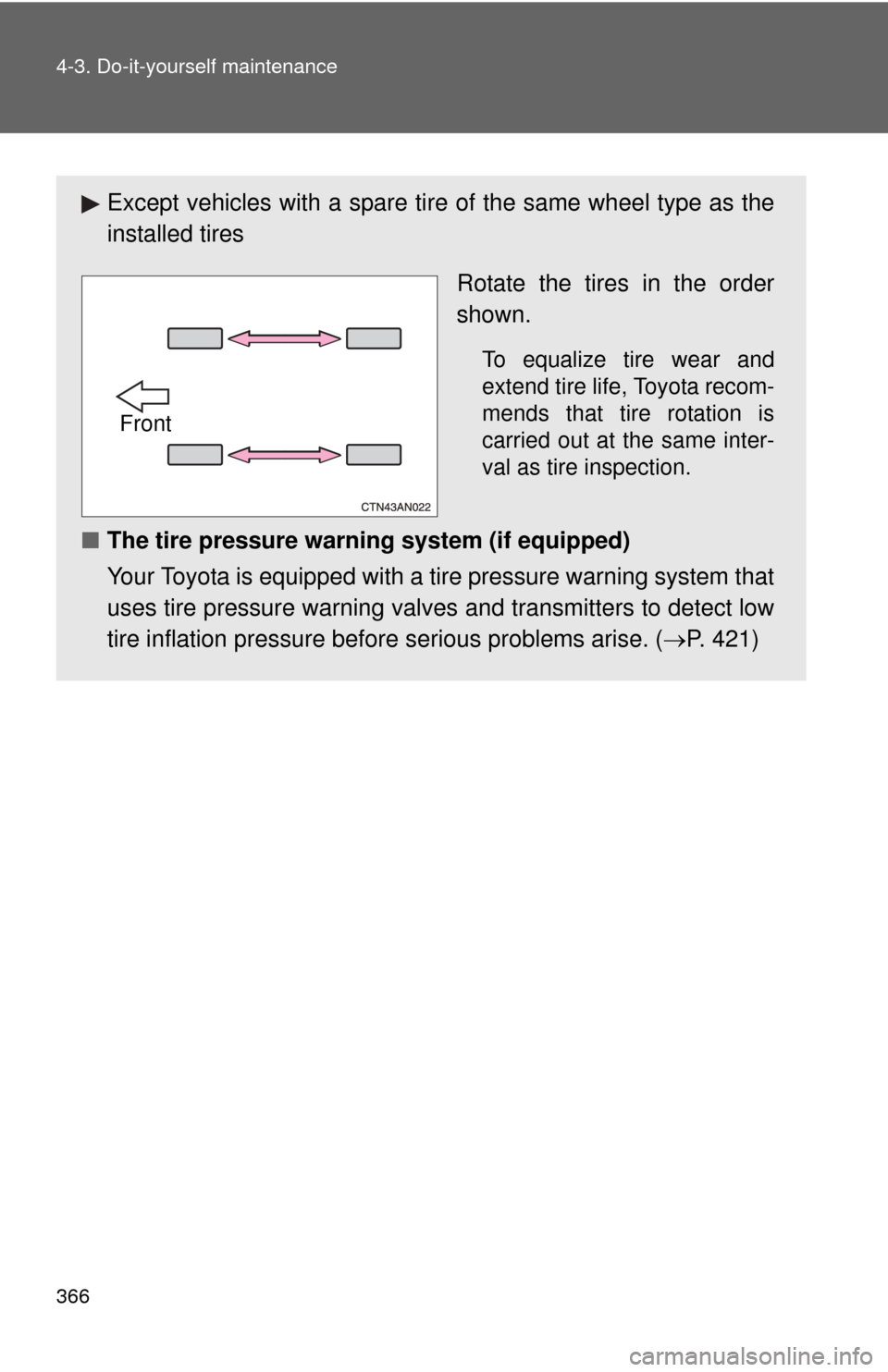
366 4-3. Do-it-yourself maintenance
Except vehicles with a spare tire of the same wheel type as the
installed tires
Rotate the tires in the order
shown.
To equalize tire wear and
extend tire life, Toyota recom-
mends that tire rotation is
carried out at the same inter-
val as tire inspection.
â– The tire pressure warning system (if equipped)
Your Toyota is equipped with a tire pressure warning system that
uses tire pressure warning valves and transmitters to detect low
tire inflation pressure before serious problems arise. (ď‚®P. 421)
Front
Page 369 of 513
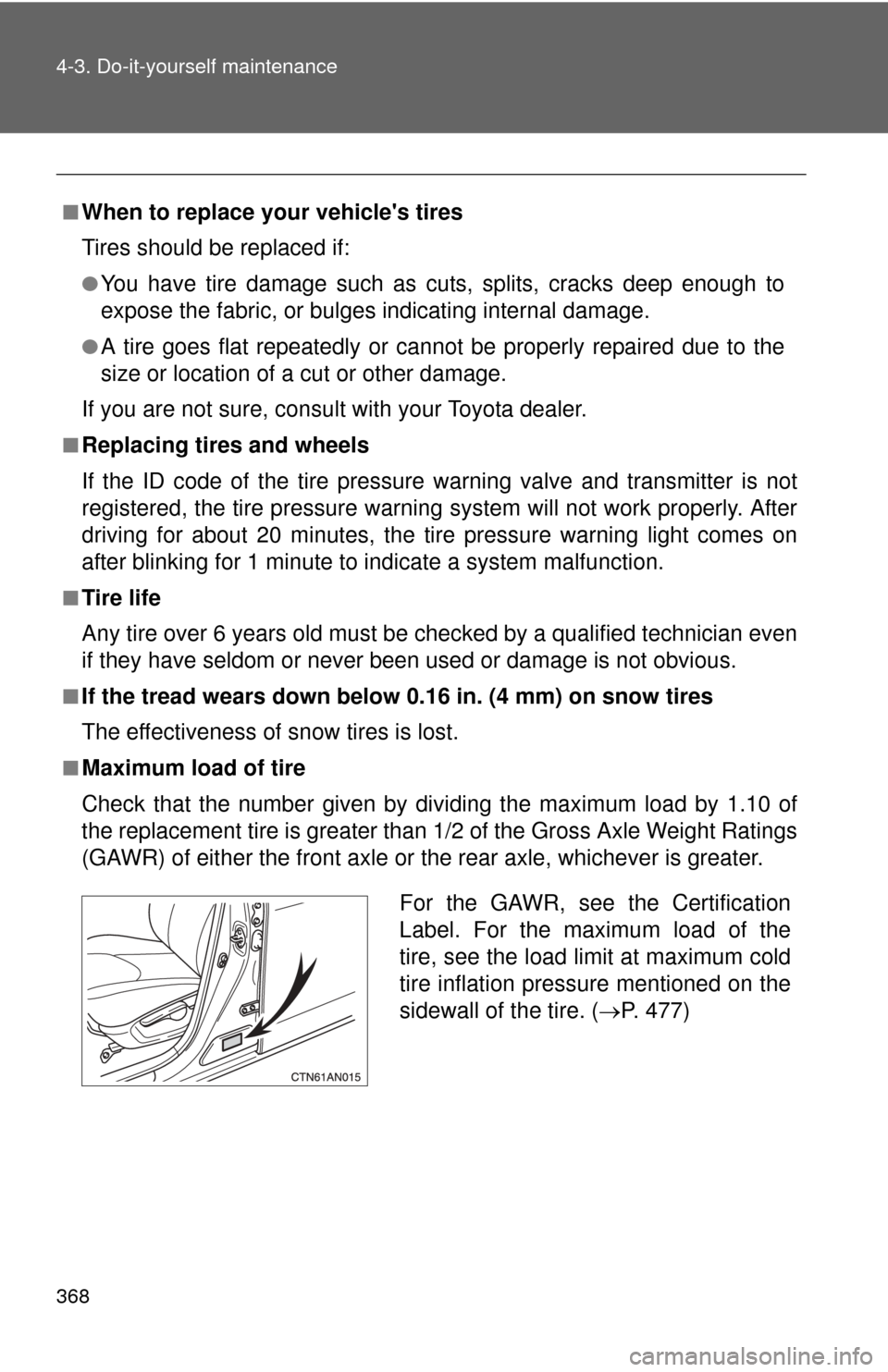
368 4-3. Do-it-yourself maintenance
â– When to replace your vehicle's tires
Tires should be replaced if:
â—ŹYou have tire damage such as cuts, splits, cracks deep enough to
expose the fabric, or bulges indicating internal damage.
â—ŹA tire goes flat repeatedly or cannot be properly repaired due to the
size or location of a cut or other damage.
If you are not sure, consult with your Toyota dealer.
â– Replacing tires and wheels
If the ID code of the tire pressure warning valve and transmitter is not
registered, the tire pre ssure warning system will not work properly. After
driving for about 20 minutes, the ti re pressure warning light comes on
after blinking for 1 minute to indicate a system malfunction.
â– Tire life
Any tire over 6 years old must be checked by a qualified technician even
if they have seldom or never been used or damage is not obvious.
â– If the tread wears down below 0.16 in. (4 mm) on snow tires
The effectiveness of snow tires is lost.
â– Maximum load of tire
Check that the number given by di viding the maximum load by 1.10 of
the replacement tire is greater than 1/2 of the Gross Axle Weight Ratings
(GAWR) of either the front axle or the rear axle, whichever is greater.
For the GAWR, see the Certification
Label. For the maximum load of the
tire, see the load limit at maximum cold
tire inflation pressure mentioned on the
sidewall of the tire. (ď‚®P. 477)
Page 370 of 513

369
4-3. Do-it-yourself maintenance
4
Maintenance and care
â– Tire types
1 Summer tires
Summer tires are high-speed performance tires best suited to highway
driving under dry conditions. Since summer tires do not have the same
traction performance as snow tire s, summer tires are inadequate for
driving on snow-covered or icy roads. For driving on snow-covered
roads or icy roads, the use of snow tires is recommended. When
installing snow tires, be sure to replace all four tires.
2 All season tires All season tires are designed to provide better traction in snow and to
be adequate for driving in most winter conditions, as well as for use
year round. All season tires, however, do not have adequate traction
performance compared with snow tires in heavy or loose snow. Also,
all season tires fall short in acceleration and handling performance
compared with summer tires in highway driving.
3Snow tires For driving on snow-covered roads or icy roads, we recommend using
snow tires. If you need snow tires, select tires of the same size, con-
struction and load capacity as the or iginally installed tires. Since your
vehicle has radial tires as original equipment, make sure your snow
tires also have radial construction. Do not install studded tires without
first checking local regulations for possible restriction. Snow tires
should be installed on all wheels. ( ď‚®P. 206)
â– Routine tire inflation pressure checks
The tire pressure warning system doe s not replace routine tire inflation
pressure checks. Make su re to check tire inflation pressure as part of
your routine of daily vehicle checks.
Page 372 of 513

371
4-3. Do-it-yourself maintenance
4
Maintenance and care
NOTICE
â– Repairing or replacing tires, whee
ls, tire pressure warning valves
and transmitters and tire valve caps (vehicles with a tire pressure
warning system)
â—Ź When removing or fitting the wheels, tires or the tire pressure warning
valve and transmitter, contact your Toyota dealer as the tire pressure
warning valve and transmitter may be damaged if not handled correctly.
â—Ź When replacing tire valve caps, do not use tire valve caps other than those
specified. The cap may become stuck.
â–
To avoid damaging the tire pressure warning valves and transmit-
ters (vehicles with a tire pressure warning system)
Do not use liquid sealants on flat tires.
â– Do not use puncture sealant sprays to repair flats (vehicles with a
tire pressure warning system)
Puncture sealant sprays may damage tire pressure warning valves and
transmitters.
â– Driving on rough roads
Take particular care when driving on roads with loose surfaces or pot-
holes.
These conditions may cause losses in tire inflation pressure, reducing
the cushioning ability of the tires. In addition, driving on rough roads may
cause damage to the tires themselves, as well as the vehicle's wheels
and body.
â– If tire inflation pressures become low while driving
Do not continue driving, or your tires and/or wheels may be ruined.